Potsdam
 General General
Potsdam, famous for the palace and landscaped park gardens of
Frederick the Great's Sanssouci, and the post-war settlement signed
by the Great Powers in Schloss Cecilienhof, is one of the best-loved
and most often visited attractions for visitors to Germany's capital.
Potsdam is the capital of Brandenburg, the Federal State that
surrounds Berlin, and lies to the South-West on the river Havel.
Its relatively small population (c.150,000) gives the city an
air of tranquility which can be refreshing after the hustle and
bustle of the capital, and somehow makes all the more surprising
the stunning range of architectural styles, landscapes and sights.
Baroque palaces vie with follies, Chinese teahouses with Roman
Baths, Russian dachas with Dutch city houses. A steam engine built
to power the Sanssouci fountains masquarades as a mosque, a Russian
Orthodox chapel perches mournfully on a hilltop, and to the west
of the city, in the suburb of Babelsberg, the site of the immense
pre-war Film Sudios where masterpieces like Metropolis and The
Blue Angel were shot before most of the directors (Fritz Lang,
FWPabst) and actresses (Marlene Dietrich) fled to escape the Nazis,
pulses with life again as TV and film companies swarm in to expolit
the magnificent facilities.
And around the city huge areas of woodland stretch down to the
Havel and its necklace of lakes - pleasure cruises drift through
dreamy canals past the waterside villas of the pre-war starlets,
bathers splash through the water at Wannsee, which sports the
longest inland beach in Europe, and picknickers sprawl amongst
the peacocks of Pfauen Insel.
History
Till the fall of the Berlin Wall in 1989 Potsdam was relatively
complicated to visit despite its proximity to Berlin since it
lay beyond the Wall in Eastern Germany. Frontier delays were long
and frustrating involving batteries of questions and often vehicle
searches. But now the traces of its long and varied history are
a short car drive or trip on the SBahn away.
Origins
Potsdam was originally a Slavonic settlement (Potzupimi) whose
inhabitants farmed and fished the Havel. Its existence is first
recorded in 993, but apart from the construction of a castle in
1160 to control the Havel trade, it changed very little during
the Middle Ages remaining a peaceful backwater until Friedrich
Wilhelm, the Great Elector (the title Elector was given to those
German Princes who chose the Emperor) decided Berlin was too crowded
and smelly, and had a second palace (Residenz) built in Potsdam.
Potsdam lay south-west of Berlin, beyond the forest of Grünewald
- the route there ran through the hunting park west of the Brandenburger
Tor, now Tiergarten, and along a raised causeway through the swampy
river valley of the Spree, now Ku'damm.
Under Frederick the Great's Hohenzollern successors the city
became an important garrison and administrative centre; the demand
for uniforms stimulated the textile industry and artisans flocked
into Potsdam. Small-arms manufacturies were established and housing
provided for the incoming workers.
Sanssouci
But it was with the ascension to the throne of Frederick the
Great in 1740 that the town was most dramatically transformed.
He initiated a building programme to the west of Potsdam which
was to continue till the early years of the 20thC - the Palace
and garden complex of Sanssouci. Potsdam was to be a cultural
oasis in the middle of barbarian Prussia, modelled on Versailles,
the palace of Louis XIV, the Sun King.
Palace after Palace sprung up, and the streets of Potsdam were
lined with baroque town houses for the middle classes drawn by
the gravity of the royal presence. In 1838 Potsdam was linked
to Berlin by rail and the town became a favourite outing for Berliners,
escaping the crowded big city to stroll in the Grünewald or swim
in the Wannsee.
The Third Reich and World War II
And it was on the shore of this idyllic lake on Jan 2nd, 1942,
that Heydrich, Eichmann and the planners of the Third Reich adopted
the Final Solution, the detailed strategy for deporting and gassing
Europe's jews in concentration camps.
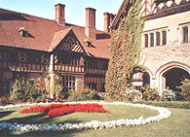 Three
years later in April 1945 a terrible bombing raid destroyed large
sections of the town, killing 4000 people, but signalling the
end of World War II. On Aug 2nd the post-war division of Europe
was agreed at Schloss Cecilienhof at the Potsdam Conference. Three
years later in April 1945 a terrible bombing raid destroyed large
sections of the town, killing 4000 people, but signalling the
end of World War II. On Aug 2nd the post-war division of Europe
was agreed at Schloss Cecilienhof at the Potsdam Conference.
The Cold War
Soon after, this division was played out on the town's doorstep
as the Allies started to fall out and Berlin became 2 cities,
hostilities culminating in the building of the Berlin Wall in
1961. Potsdam found itself in East Germany, now separated from
encircled West Berlin by a Wall and linked only by the Glienicke
Bridge over the Havel, the bridge that features in films from
the Cold War where spies are swapped between West and East.
In Potsdam itself the SED, the East German Communist Party, implemented
a dramatic programme of demolition, building prefabs to house
the immense numbers of homeless, preferring this to reconstruction,
partly for economic reasons, but also because they felt uncomfortable
with the city's imperial past. And so Potsdam remained, surrounded
by the red brick barracks of the Soviet Army of occupation, till
1989 and the fall of the Berlin Wall.
Re-unification
After the re-unification of Germany the SBahn, water and road
links between Berlin and Potsdam were reopened, the remaining
older buildings in the town centre are undergoing an extensive
renovation programme and the town draws increasing numbers of
visitors who come to marvel at its Baroque splendours.
Park "Sans Souci"
In 1744 Frederick the Great ordered the construction of his dream
palace of Sanssouci 2 kms to the west of the centre of Potsdam.
The French name means "carefree". Frederick had been brought up
strictly by his tyranical father, the Soldier King, who had had
the young Frederick's lover, an officer named Katte, beheaded
in front of him, had forced him into an arranged marriage with
Elisabeth Christine, and had the habit of forcing his son to kiss
his boots in public, until the young man escaped to the palace
of Rheinsberg (another beautiful baroque building to the north
of Berlin). On his father's death, Frederick attempted to reproduce
the cultured atmosphere of Versailles in what he considered the
bleak wasteland of militaristic Prussia.
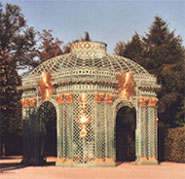 The
architect he commissioned to build his palace was Georg von Knobelsdorff,
and Sanssouci was completed the following year and the park, the
Rehgarten (the deer garden), 5 years later. The buildingprogramme
continued unabated till the early years of the 20th Century. The
Neues Palais (the New Palace) at the west end of the park was
built to commemorate the end of the Seven Years War, and the Orangerie
and Mulberry Alley added in 1913. The
architect he commissioned to build his palace was Georg von Knobelsdorff,
and Sanssouci was completed the following year and the park, the
Rehgarten (the deer garden), 5 years later. The buildingprogramme
continued unabated till the early years of the 20th Century. The
Neues Palais (the New Palace) at the west end of the park was
built to commemorate the end of the Seven Years War, and the Orangerie
and Mulberry Alley added in 1913.
You enter the Park from the east passing through the Obelisk
Portal flanked by the Roman goddesses Flora and Pomona and, passing
through the Dutch Garden, arrive at the Great Fountain, with its
statues of Venus and Mars. To the north, rows of terraces with
some of the northernmost vines in Europe climb up to Sanssouci
itself - from the uppermost terrace a rather surreal view of the
old East German prefabricated tower blocks of the Neustädter Havelbucht
open up, contrasting strangely with the twin wings of the baroque
palace, with its green dome, gold leaf and sun symbols.
The interior boasts 12 Rococo rooms, each in different decorative
styles, including the Marble Hall, a Concert Room, and a private
library of 2000 books (mostly in French, the language of the court),
where Frederick lived and entertained. For a brief while the French
philosopher Voltaire was his private tutor (1750-3), but as the
King got older he became more and more cranky, the early promise
of liberalism did not bear fruit, and he quarrelled acrimoniously
with Voltaire. On his departure the King had the philosopher's
bedroom redcorated with motifs of parrots and monkeys.
The increasingly eccentric "Alte Fritz" became a recluse - his
dying wish was to be buried next to his greyhounds in a tomb near
the eastern wing, but his nephew instead placed him next to his
detested father in the Garrison Church in Potsdam, and there he
lay until the end of World War 2 when he was exhumed and transported
to Schloss Hohenzollern in Suabia to escape the advancing Soviet
troops. Only in 1991 was the body returned to Potsdam wher he
now lies buried under a simple stone memorial near Sanssouci.
To the east of the palace is the Bildergalerie, his private art
collection, including works by Rubens, Vasari, Van Dyck and Caravaggio,
scattered during the war but now largely reassembled. Further
east lies the Neptune Grotto, a folly designed by Knobelsdorff,
originally boasting Moorish statues.
Complementing the Bildergalerie, to the west of Sanssouci, lies
the Neue Kammern, where Frederick's guests were housed, and beyond
that the Sicilian and North European Gardens, a rock gateway with
an eagle perched on it, and a reconstructed wooden windmill.
To the north of the palace, a vista leads gently uphill towards
a pile of ruins on a hilltop. This folly was built to conceal
a reservoir intended for water to drive the park's foutains, but
attempts to fill it with water from the Havel failed dismally.
The central alley running east-west through the park leads to
the New Palace, built 1763-9 at the end of the Seven Years War.
The roof is topped with 428 sandstone statues, and a green dome
embellished with a crown. This was Frederick's (and the later
Hohenzollerns') private residence, and the interior is opulent,
including the Grotto room, whose walls depict dragons and lizards
formed from shells and semi-precious stones, an enormous marble
chamber, and Frederick's private theatre where performances of
French plays and Italian operas were presented.
Facing the west entrance to the palace are the Communs, the colonnaded
quarters for the palace servants.
Running north-east, at an angle to the main alley is the Mulberry
Alley. On the northern side the Italianate Renaissance Orangerie,
with its towers and lions head water spouts, was built by a later
Hohenzollern monarch, Frederick IV, who was much impressed by
the Italian architecture he had observed in Italy on his Grand
Tour. It functions now as a hothouse for tropical plants, an art
gallery with copies of paintings looted by Napoleon, and also
houses the current park workers.
South of the Orangerie a goldfish pond is to be found, together
with a statue of Frederick the Great - a copy of that which can
be seen on Unter den Linden.
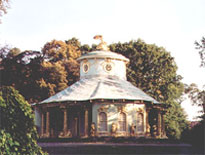 The
park, which was originally intended as hunting ground and a kind
of playroom for the wealthy Hohenzollern family, sports many other
visual delights - fantasies such as the Chinese Teahouse (the
Dragon House) where the King's vintner was accomodated, the mock
Roman Baths designed by the architect Schinkel, an enormous Toy
Fortress with miniature canons, an antique temple, a Belvedere,
a Hippodrome style arena, the villa Schloss Charlottenhof, and
the beautiful lakeside Friedenskirche Church, where many of the
royal family are interred. The
park, which was originally intended as hunting ground and a kind
of playroom for the wealthy Hohenzollern family, sports many other
visual delights - fantasies such as the Chinese Teahouse (the
Dragon House) where the King's vintner was accomodated, the mock
Roman Baths designed by the architect Schinkel, an enormous Toy
Fortress with miniature canons, an antique temple, a Belvedere,
a Hippodrome style arena, the villa Schloss Charlottenhof, and
the beautiful lakeside Friedenskirche Church, where many of the
royal family are interred.
Alexandrowska
The Russian colony of Alexandrowska was constructed for 62 members
of a military choir taken prisoner in Latvia during the Napoleonic
Wars. The settlement is laid out like a St. Andrew's cross, with
the overseer's house placed at the intersection, and the individual
houses are built in Russian style with plank cladding and the
names of the families that originally lived there carved on the
doors. On a hill above the settlement is a tiny Eastern Orthodox
Church, the Alexander Newski Chapel, with its onion dome, pink
stucco and icons. After the October Revolution in what became
the Soviet Union, thousands of Russians fled to Germany and services
have been conducted in the Chapel since then.
To the north, at the foot of the Pfingstberg, another hill, lies
a walled Jewish Cemetery, from the year 1763. Between 1933 and
1945 the Jewish population of Potsdam was almost entirely deported
and murdered.
Neuer Garten
The New Garden stretches round the west side of the Heiliger
See (the holy lake). It contains the Marble Palace, built for
Frederick William II, who died there in 1797, reportedly as a
consequence of his dissolute lifestyle. In the DDR (old East Germany)
it became a military museum.
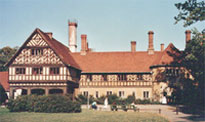 The
most famous building in the park is the Schloss Cecilienhof, built
1913-17 - a mock-Elizabethan stately home where the post-war Potsdam
Conference took place in July/Aug 1945, attended by Truman, Stalin
and Churchill (later replaced by Atlee). After an arson attack
on the conference hall in 1990, it has been now restored, and
visitors can view the chintzy decor in the delegates' rooms and
contemplate the different amount of space alloted the different
delegations. The
most famous building in the park is the Schloss Cecilienhof, built
1913-17 - a mock-Elizabethan stately home where the post-war Potsdam
Conference took place in July/Aug 1945, attended by Truman, Stalin
and Churchill (later replaced by Atlee). After an arson attack
on the conference hall in 1990, it has been now restored, and
visitors can view the chintzy decor in the delegates' rooms and
contemplate the different amount of space alloted the different
delegations.
Across the lake the expensive villas of the Potsdamer Vorstadt
can be glimpsed. This is where the directors and starlets of the
pre-war film industry resided, to be followed, in the DDR, by
government functionaries. And beyond the Vorstadt, along the Berliner
Strasse leading to Berlin, is the Glienicke bridge where Gary
Powers, the U2 pilot, was swapped and where Anatoly Scharansky
was released.
The City of Potsdam
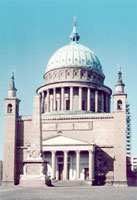 The
oldest part of Potsdam is the area around Am Kanal and Fischerstrasse,
close to the island in the Havel where it runs southwards from
the Tiefer See. Here was the earliest Slavonic fishing settlement. The
oldest part of Potsdam is the area around Am Kanal and Fischerstrasse,
close to the island in the Havel where it runs southwards from
the Tiefer See. Here was the earliest Slavonic fishing settlement.
When the town became an important administrative centre for the
Hohenzollerns it was enclosed with a city wall. Several of the
original city gates (reconstructed) are still in evidence. They
bear the names of the German towns where roads out of Potsdam
led: the Brandenburger Tor (1770), the Jägertor (1733) and the
Nauener Tor (1755).
The baroque town centre is organised round a number of squares.
The Platz der Einheit (Unity Square, earlier Wilhelmplatz) has
a mock baroque post office in the south-east corner, to its north
was the synagogue. Further north again lies Bassinplatz with the
first catholic church in the town, the Peter-Paul Church, modelled
on the campanile of the Sam Zeno Maggiore in Verona, and the French
Church, designed ny Knobelsdorff as a copy of the Pantheon in
Rome.
To the South-east of the square, the Old Market leads to the
Nikolaikirche, a domed neo-classical building designed by Schinkel
with an interior displaying painted events from the New Testament.
Opposite the church, the former Palladian Townhall adorned with
a statue of Atlas holding a golden globe aloft is eye-catching
and of interest not least because of its history. The circular
tower served as the town prison till 1875. 10 years later the
building became a bank; in the DDR it was transformed into a cultural
centre. The obelisk in front of the building was designed by Knobelsdorff
and depicts the four architects who were resposible for so many
of Potsdam's buildings: Knobelsdorff, Schinkel, Perseus and Gontard.
Other sights of note in the centre include a wonderful row of
Baroque city houses in Yorckstrasse, the Kabinetthaus on the New
Market - the palace where Frederick William II was born, the Marstall
(the former orangerie then royal stables) which now houses Potsdam's
film museum, and not least the Pumphouse designed by Perseus to
drive the fountains in Sanssouci which is built in the shape of
an oriental mosque with minaret.
The Dutch Quarter is one of the most striking areas of the town,
boasting a remarkable collection of 128 red-brick, high gabled
Dutch terraced houses built around 1740.These were erected to
house Dutch engineers invited by Frederick William I to assist,
in their role as water specialists, with canalisation in Potsdam
and the surrounding area. Potsdam (like Berlin) is predominantly
flat with sand and clay soil, and drainage posed regular problems.
The houses, with their high stepped rooves, are in the process
of restoration and this area of the town is moving upmarket rapidly.
Babelsberg
To the east of Potsdam lies the suburb of Babelsberg. It was
here that the largest film studio in Europe grew up in the 1920s,
the famous UFA Studios. Here films like Fritz Lang's Metropolis
and The Blue Angel, and Wiene's The Cabinet of Doctor Caligari
were shot, actresses like Marlene Dietrich and directors like
FW Pabst worked, before they fled the Nazis, many moving to Hollywood.
Under the Thrid Reich the studios were used to shoot many anti-semitic
propaganda films, and under the Communist regime the state production
company DEFA was based here.
Nowadays the site is the base for many smaller independant film
and TV production companies, as well as hosting foreign film productions
- recently the remake of Stalingrad was shot here. It also offers
a Film Theme Park, with collections of sets, properties, costumes
and models from the early days of the film industry, and a virtual
3D ride.
Babelsberg's other sights include a 19th century Telegraph Station
which has been converted into an astronomical observatory with
a 1920 observation tower where Einstein carried out some of his
experiments into the Theory of Relativity, and the Park Babelsberg
with its palace, a mock-gothic fantasy by Schinkel and the Matrosenhaus
(sailors' house) for the men who sailed the royal barges along
the rivers and canals that surround Potsdam.
© 2001-2002 Berlin Travel Service - A1 Design All rights reserved.
|